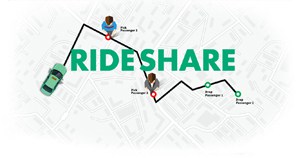My answer to you would be ‘No. No, you don’t.’ Why would you want a private citizen in a private (and ill-equipped) vehicle to take you to the hospital in any situation? In an emergency situation, where you (or someone you’re with) have made the clear-headed decision that Uber is preferred to a 911 call, it presumably would be suicide – which would be strangely ironic given that you’re probably seriously injured or ill and at high risk of death anyway.
In this situation you need a trained first responder with the right equipment to treat you at the scene and/or while en route to the hospital. Someone who can run red lights and jump traffic to get you to the right facility to treat you. Think about this: you’re having serious chest pains and some guy in a silver Toyota shows up at your front door (five minutes late) and struggles to find the route on his GPS so he can get you to the hospital you’ve asked to be taken to, all the while stopping dutifully at all stop signs, traffic signals and getting caught behind 18-wheelers while the path for oxygen to get to your heart is slowly blocked. Apparently Uber even agrees with me and issued a statement to this effect a few weeks ago.
And if it’s not an emergency (ie chest pain, gunshot wound, motor vehicle accident, etc or something equally dire), how is this any different from someone driving themselves to the hospital on their own? If you’ve broken a metatarsal or suffered a mild burn, couldn’t you just drive yourself to the emergency department on your own anyway? Sure you could. But behaviourally, there’s a big difference between letting people do this on their own and encouraging them to do it. This is not the best use of a health ‘nudge’.
 I’m sure we can all agree on the need for ambulances to respond to emergency situations, not ordinary citizens in private vehicles. With low-acuity illnesses the waters get muddied: some policymakers and provider groups think that a ride-sharing service might help alleviate some of the burden on the system by freeing up ambulances for ‘real’ emergencies. This is a laudable but flawed notion. Making it easier for people to clog the emergency rooms by encouraging citizens (or at least looking the other way when they do) to use their favourite ride-sharing service to take them to the hospital is not the answer. We ought to be ‘nudging’ people, in low-acuity scenarios, to see their primary care physician as soon as possible if we really want to reduce the bottleneck at the ER level and impact both user and system cost – not encouraging people to go to the ER via a ride-sharing service.
I’m sure we can all agree on the need for ambulances to respond to emergency situations, not ordinary citizens in private vehicles. With low-acuity illnesses the waters get muddied: some policymakers and provider groups think that a ride-sharing service might help alleviate some of the burden on the system by freeing up ambulances for ‘real’ emergencies. This is a laudable but flawed notion. Making it easier for people to clog the emergency rooms by encouraging citizens (or at least looking the other way when they do) to use their favourite ride-sharing service to take them to the hospital is not the answer. We ought to be ‘nudging’ people, in low-acuity scenarios, to see their primary care physician as soon as possible if we really want to reduce the bottleneck at the ER level and impact both user and system cost – not encouraging people to go to the ER via a ride-sharing service.
We tend to think that everything in healthcare is broken and that any cost to the system is too high
The individual patients, on the other hand, look at cost and control as the main motivators: it costs me less to use Uber than an ambulance and I can control which hospital the driver takes me to. From a messaging perspective, it sounds like a perfect PR campaign: let’s reduce costs to the system for the user and free up more of our ambulances to focus on the critically and severely injured.
Here’s a big part of the problem: when you’re in a high or low acuity situation and you call Uber and tell the driver to take you to the hospital down the street, you have no idea if that hospital is the best hospital for your needs. You don’t know if that hospital has a catheterisation lab or a burn unit and whether it is available to take you. And you also don’t know how to manage load balance – which is the efficient triaging and distribution of patients across the entire emergency medical services landscape to ensure that the right patients get to the right hospital to meet their medical needs and, equally, to ensure that no single hospital becomes overwhelmed by an influx of emergency service demands.
So we agree that in ‘pure emergency’ situations, this will not work. And we probably agree that in low-acuity scenarios, this probably isn’t a good idea because triaging both patient load and availability of medical services is central to ambulance services and can’t be outsourced or left to chance.
So why are we still talking about this as a possibility? Because we are conflating two issues: the use of ride-sharing services in place of ambulance services and the use of ride-sharing services to shuttle patients to their medical appointments. The former is a disaster. The latter is already happening and is a value-added service that hospital systems may provide to save their patients money and to make it more convenient to access services.
And truthfully, we continue to talk about it because we tend to think that everything in healthcare is broken and that any cost to the system is too high. In truth, some aspects of the system and their associated costs are just fine. Not perfect. Not optimal. Not flawless. But just ‘fine’. And sometimes ‘fine’ is all we need.





